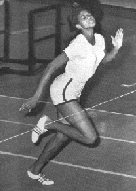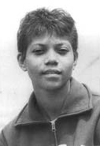
Wilma Rudolph: A Story of Determination
Wilma Rudolph overcame long odds to become one of the world's best-known athletes. How and why she did what she did are as amazing as her accomplishments.
She was born on June 23, 1940, in Bethlehem, Tennessee. She was born premature, or early, and so she was a weak baby. She was born into a large family (the 20th of 22 children), in a time when African-Americans weren't at the top of the list to get help at America's finest hospitals. She had many diseases as a child, including polio, scarlet fever, and pneumonia; one result of this was that her left leg was partially deformed.
She wouldn't give up, however, and was determined to be like any other child. She wore braces to help herself walk. Her family gave her daily massages on her leg and also drove her to physical therapy sessions. All of these things put together led to the astonishing development of Wilma's taking off the braces entirely when she was 9. Two years later, she was playing basketball! (In her later life, she was fond of saying this: "My doctors told me I would never walk again. My mother told me I would. I believed my mother.")
Rudolph proved to be a remarkable athlete and caught the attention of the track coach at nearby Tennessee State University, who coached her in track throughout her high school years. She never lost a high school track meet and attended college practices while she was still in high school. At age 16, Wilma competed for and won a spot on the U.S. Olympic Team. Her 4x100-meter relay won the bronze medal at the 1956 Olympics in Melbourne, Australia.
 She kept running and got better and better. She enrolled at Tennessee State and continued to win track meets. At the 1960 Olympics in Rome, she became the first American woman—white or black—to win three gold medals in one Olympics. She won the 100 meters, 200 meters, and 4x100-meter relay. Many people called her the "World's Fastest Woman." She was named the Associated Press Female Athlete of the Year. She kept running and got better and better. She enrolled at Tennessee State and continued to win track meets. At the 1960 Olympics in Rome, she became the first American woman—white or black—to win three gold medals in one Olympics. She won the 100 meters, 200 meters, and 4x100-meter relay. Many people called her the "World's Fastest Woman." She was named the Associated Press Female Athlete of the Year.
Suddenly, Wilma Rudolph, who was once a little girl who couldn't walk without the help of leg braces, was an international track star. She toured other countries, winning big cheers in England, Germany, Greece, and the Netherlands. When she spoke, people listened.
Her return home to Tennessee was a momentous occasion as well. The governor of her home state wanted to have a victory parade for her, but Rudolph wouldn't allow it unless it didn't include restrictions on people's skin color. The governor agreed, and the parade was the first integrated event in Clarksville, where she had lived since she was very young.
 Rudolph remained a public figure, working to help young athletes get better and to improve the rights of African-Americans. She worked as a track coach at DePauw University, in Indiana. She created the Wilma Rudolph Foundation to help young athletes get the recognition and support they deserved. She was voted into the National Track and Field Hall of Hame, as well as the Black Athletes Hall of Fame and the U.S. Olympic Hall of Fame. She was also a sports commentator. Rudolph remained a public figure, working to help young athletes get better and to improve the rights of African-Americans. She worked as a track coach at DePauw University, in Indiana. She created the Wilma Rudolph Foundation to help young athletes get the recognition and support they deserved. She was voted into the National Track and Field Hall of Hame, as well as the Black Athletes Hall of Fame and the U.S. Olympic Hall of Fame. She was also a sports commentator.
In 1963, she married Robert Eldridge; they had four children.
Sadly, she died of brain cancer on November 12, 1994. She was just 54. She was remembered as an amazing athlete and a powerful voice for African-Americans and their struggle for equality.
"Never underestimate the power of dreams and the influence of the human spirit. We are all the same in this notion. The potential for greatness lives within each of us."
|